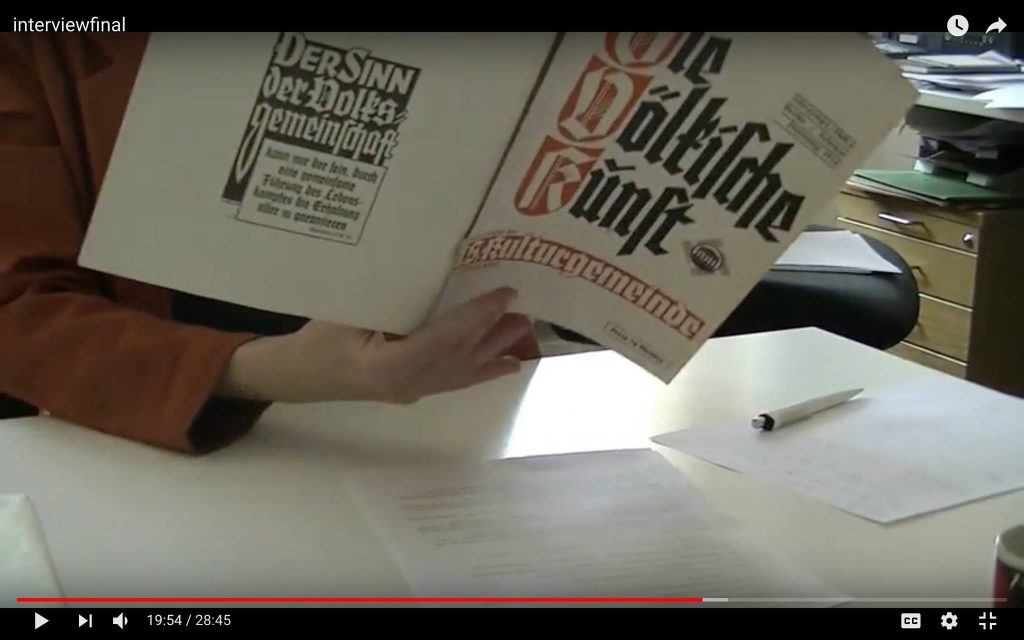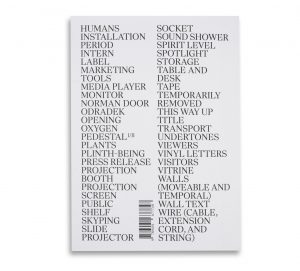Theun Okkerse: Nightflag (2019)

Flag hoisted in Dordrecht, Netherlands, on the night of 27/28 June 2019.

Flag hoisted in Dordrecht, Netherlands, on the night of 27/28 June 2019.

From April 26 to April 28 Edmund Felson presents untitled (a living hippopotamus adopted collectively),
an exhibition by Steve Giasson at Gallery Weekend Berlin.
The Edmund Felson Gallery represents and works with internationally acclaimed contemporary artists. Each featured artwork is presented on and/or around the gallerist. Located in public space – on the bustling side walks of international capitals, in front of the most important art fairs of our time, next to renowned museums and collections.

Off the record, on the QT, and very hush-hush
Sid Hudgens, L.A. Confidential

TonKraayeveld.nl
photo © FvL
On the 23th of June 2013 I decided to make a paper cube which measured 2cm.
Since that date I make one cube every day. The cubes are copied from the model of their predecessor, so small imperfections are slowly increasing. This project is still in progress and will end when it is no longer possible to make a closed volume.
THE MAP IS THE TERRITORY
For the 4th edition of the BregenzBiennale French curator Sophie Lapalu and Austrian artist Albert Allgaier, co-founder of the BregenzBiennale, invited 46 international artists to create site-specific invisible interventions in and around Bregenz, Austria.
The biennale’s motto THE MAP IS THE TERRITORY reconciles radical conceptualism with subversive performance through a guide map that also works as the exhibition catalogue. Ranging from shamanistic rituals in the Casino to watering flowers with LSD, the works presented at the BregenzBiennale2018 juxtapose the poetic everyday with the mysterious and metaphysical.
Lina Aušra, Francisco Babo, Samuel Bich, Simone Borghi, Elena Borghi, Godomira Buroskwy, Kevin Desbouis, Damien Dion, Victoria Durnak, Jona Einarson, Stefano Faoro,FAXEN, Romain Gandolphe, Steve Giasson, Akba Gurundi, Token Black Guy, Tim Hartmann, Stefanie Heine, Robert Huber, Florence Jung, Fatmir Mustafa Karlo, Stefan Klein, Marika Konstantinidou, Mikko Kuorinki, Sophie Lingg, Mmmmmegumi, José Oliveira, Will Owen, Alice Pamuk, Philipp Preuss, Anahita Rahzmi, Christopher Richmond, Valentine Ridde, Karl Salzmann, Liv Schulman, Driton Selmani, Lena Sieder-Semlitsch, Semino Spataro, Martin Sturm, Andreas Trobollowitsch, Emmanuel Troy, Salvatore Viviano, Robin Waart, Dimitri Waschkov, Noboru Watanabe & Bernhard Weber.
The BregenzBiennale is supported by Land Vorarlberg and Bundeskanzleramt Österreich.

Joshua Schwebel was invited to participate in the group show ‘Interventionen’ at the Heimatmuseum Reinickendorf in Berlin. Schwebel proposed to work with the museum’s Nazi artefacts. A video was made of the museum director handling and discussing these objects. Schwebel then addressed a letter to the director, proposing an artistic-symbolic reparation:
Dear Frau Dr. Gerner, Director, Museum Reinickendorf:
I am writing to follow-up from our interview last week, and to add a further act to my work. This letter and your response will become part of the work I will display in the upcoming exhibition.
I have been thinking ceaselessly about the objects we discussed in our conversation. How these glittering swastikas and adorned certificates made me tremble. They sat before us in archival envelopes as we talked, and I spoke with you about them as though I, too, recognized their historical value.
In our conversation you described how these objects were ‘donated’ to the museum anonymously and without adequate historical information, and that this lack of correct and complete data is disappointing from a museological perspective. Either the donors felt ashamed to have these souvenirs of NS times in their family’s possession, or else they wished that these objects endure as historical artifacts of the region. In either case, the artifacts themselves do still endure, and because they are under the aegis of the museum, they survive and are protected. I certainly recognize the importance of documenting, discussing, and acknowledging the historical events from this time, however, I cannot understand why it is necessary to preserve its objects.
I cannot but feel angry that I see no equivalent artifacts of Jewish culture and its everyday history existing in your museum. It is quite evident that there were Jews living in Reinickendorf, at least until NS times. But Jewish objects did not find their way into museum collections because they were stripped from bodies, which were also melted, burned, or otherwise rendered into fuel for war, hatred, and Capital. Jews are represented by death markers here.
In response to this asymmetry, I wish to work with you to perform a gesture of reversal: A repatriative extraction. Working together with you, I want to arrange for the long-term removal of one of the many Nazi artifacts from your museum. While this extraction can only serve a symbolic purpose, its effect would introduce a real absence into your collection; an absence which speaks more broadly to the collecting activities of museums, many of which retain similar problematic objects also justified by their historical value. The particular artifact and the exact extraction protocol can be negotiated with you, either a long-term loan or bequeathment, but on the agreed-upon date I will put an object in my pocket and leave the museum. I will not photograph, exhibit or sell the object, nor will I destroy it. I will act as a vehicle for the object’s release from the museum, its removal from the historical remembrance it does not deserve, and relieve the museum of the burden of its preservation. The absence remaining in its place – an empty glassine envelope and description of the no-longer present object – will bookend the absence pertaining to the provenance of these objects, and the representational absence of Jewish life in the district.
I look forward to your response,
April 16, 2018
Yours,
Joshua Schwebel
As a result the museum has closed communication with the artist, and refuses to allow the artist to exhibit his letter. Schwebel’s work has been subsequently excluded from the exhibition, and Schwebel has received no response as to whether the museum will honour its contract to pay the artist for his work.
His name is no longer listed online amongst the contributing artists.
Inspired by the everyday, Johannes Langkamp (Laer 1985) makes short fragments of video with simple means, in a raw and sketchy style. His ideas develop during his experiments with the characteristics and the limitations of his tools (cameras, situations, displays), and through this process Langkamp works out rough sketches into installations that reveal the camera’s relationship with space.
In 2011 Langkamp resolved to make one video every day, during a month. These videos are often short and often a bit awkwardly recorded. The subsequent project was a ‘Video sketchbook’, a series of short films in which the camera itself becomes the main subject: it is crushed between elevator doors or mounted on an electric drill. The work of Langkamp is based on simple observations, presenting physical reality in an unusual and personal way.

The Standard Book of Noun-Verb Exhibition Grammar is a partial compendium of the different modes of being that inhabit exhibitions. These different modes of being, often placed outside the realm of art objects proper, are described and activated here as crucial players in the world of contemporary art.
 Maximizing a poetic resourcefulness, this book proposes the exhibition as an ecology full of things that are infinitely more dimensional than their ascribed functionality would lead us to believe, and creates a space where species meet, where ontological and epistemological registers clash, overlap, and contaminate each other, where the living and inert, organic and inorganic exchange properties, qualities, and performances.
Maximizing a poetic resourcefulness, this book proposes the exhibition as an ecology full of things that are infinitely more dimensional than their ascribed functionality would lead us to believe, and creates a space where species meet, where ontological and epistemological registers clash, overlap, and contaminate each other, where the living and inert, organic and inorganic exchange properties, qualities, and performances.
Ultimately this book aims to show that what revolves around, within, and beyond any given system, resolves to be just as serious and important as what that system aims to convey.
Niekolaas Johannes Lekkerkerk: The Office For Curating
Onomatopee

At first glance this image appears to be an aerial view of a hilly landscape; a river flowing through the sort of geological rock formations that take shape over eons as various forces act upon them. In fact it is a heavily magnified view of the surface of the KW/AGs Tom Thomson painting, a macro view of the tiny point where three brushstrokes intersect. (demarcated by a rectangle below the red arrow in the second photo.)
Like the landscape itself, this painting is not immune to transformative physical forces. Moisture, heat, cold, expansion and contraction are reconfiguring its surface as well. Cracks appear and brushstrokes slide around like tectonic plates.